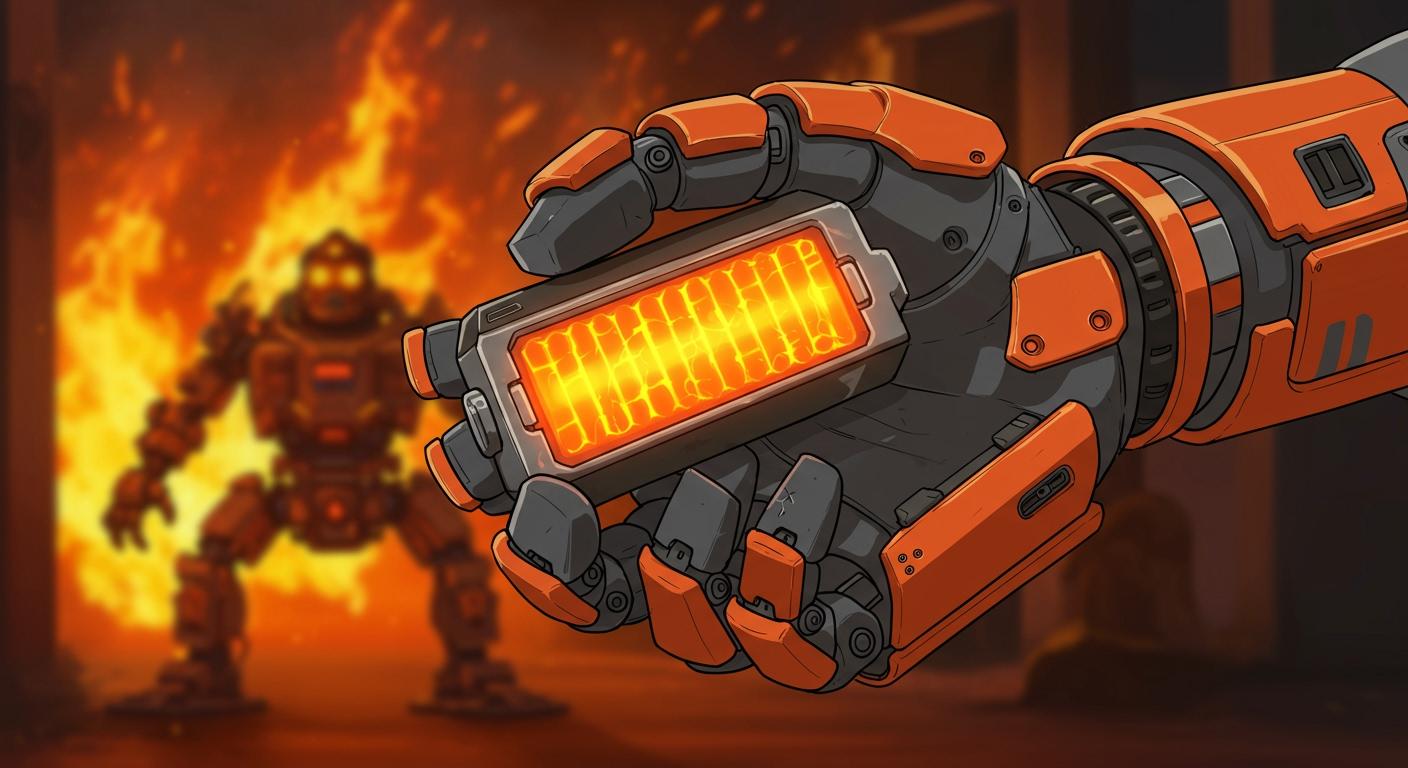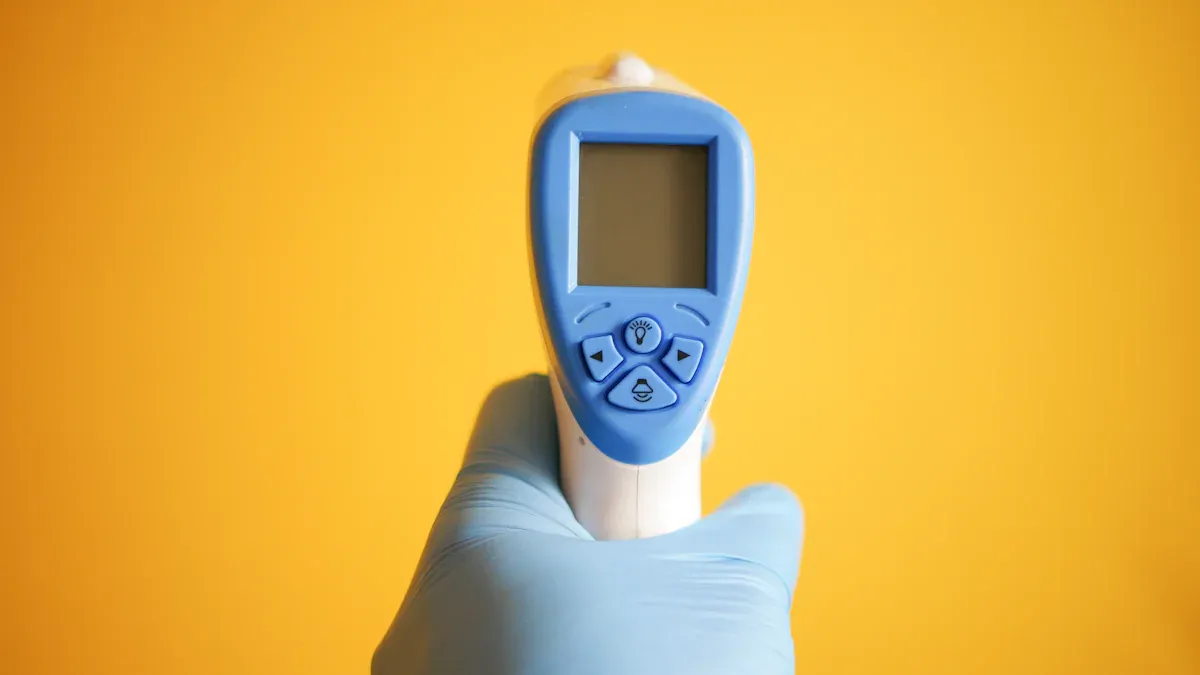
When you design heat-resistant batteries for firefighting robots, you must protect them against intense fire. Batteries face high temperatures, constant fire exposure, and risk of explosion. You use aerogels, ceramic blankets, and glass fiber to shield cells from fire. Exterior covers and cooling systems stop fire from reaching the battery core. If you ignore fire, you risk thermal runaway, short circuits, or overcharging. The table below shows common causes of battery failure in fire:
Cause | Explanation |
|---|---|
Thermal runaway | A rapid and uncontrollable rise in temperature that can lead to battery failures and fires. |
Suboptimal thermal management | Inadequate heat dissipation can lead to rising temperatures and trigger thermal runaway. |
Overcharging | Excessive charging increases internal resistance, converting charge current to heat, risking thermal runaway. |
Short circuit | Intense current flow can generate heat, increasing the risk of thermal runaway. |
Manufacturing defects | Defects during manufacturing can lead to internal short circuits, increasing thermal runaway risk. |
Operation in extreme temperatures | Prolonged use outside recommended temperature ranges can trigger thermal runaway. |
You need to manage fire threats and keep battery performance strong, even when fire temperatures rise above 1000°C. You must focus on explosion-proof design, reliability, and advanced thermal protection.
Key Takeaways
Use advanced thermal protection materials like aerogels and ceramic blankets to shield batteries from extreme heat.
Implement redundant safety systems to ensure battery reliability during fire emergencies, including automated shutdowns and backup cooling.
Select the right battery chemistry, such as LiFePO4 or solid-state, to enhance fire resistance and prevent thermal runaway.
Combine effective cooling methods, like liquid cooling and radiant covers, to manage heat and protect battery performance in firefighting robots.
Conduct thorough testing in simulated fire conditions to ensure batteries can withstand extreme temperatures and prevent failures.
Design Challenges
1.1 Extreme Heat Exposure
You face one of the toughest obstacles when you design batteries for firefighting robots. Fire can reach temperatures above 1000°C. Lithium battery packs must survive this intense heat without failing. When fire surrounds the battery, the risk of explosion or thermal runaway rises sharply. You see this in the way temperature behaves inside battery packs:
Location (cm) | Temperature Behavior |
|---|---|
0 | Similar initial behavior before thermal runaway |
10 | Similar initial behavior before thermal runaway |
20 | Similar initial behavior before thermal runaway |
40 | Similar initial behavior before thermal runaway |
Above 1000°C | Dramatic increase due to thermal runaway flame |
Fire attacks every part of the battery. You must use advanced fire protection materials and design strategies to keep the battery core safe. If you ignore these threats, fire can cause the battery to explode or catch fire. You need to block heat, slow down fire spread, and prevent thermal runaway. Every layer of protection matters. You must test batteries in simulated fire conditions to understand how fire moves through the pack. You learn that fire can change direction and intensity quickly. You must prepare for every possible fire scenario.
1.2 Safety and Reliability
You must guarantee safety and reliability in every firefighting robot. Fire creates unpredictable hazards. You need batteries that work even when fire damages sensors or wiring. You follow strict safety standards to protect people and property:
UL 9540 checks the safety of energy storage systems and thermal management.
UL 9540A tests how fire spreads during thermal runaway.
NFPA 855 gives guidelines for safe installation and fire suppression.
You also:
Comply with local siting and zoning rules.
Use remote sensors to monitor fire risks.
Develop emergency plans with first responders.
You must design lithium battery packs that keep working during fire emergencies. You need to build systems that detect fire early and shut down safely. You must balance fire protection with battery performance. Reliability means the battery works every time, even when fire threatens the robot. You cannot compromise on safety. Every firefighting robot depends on batteries that resist fire and deliver power when it matters most.
Heat-Resistant Batteries: Key Features

2.1 Thermal Protection Materials
You need to select the right thermal protection materials to keep heat-resistant batteries safe during fire. These materials act as barriers, slowing down heat transfer and protecting the battery core. You often use aerogels, ceramic blankets, glass fiber jackets, and encapsulating foams in battery insulation.
Silica-based aerogels have extremely low thermal conductivity, sometimes as low as 0.013 W/(m·K). This means they block heat very effectively, even when fire temperatures rise above 1000°C.
Glass fiber composites also provide strong insulation, with thermal conductivity values of 0.025 W/(m·K) at 300°C and 0.030 W/(m·K) at 600°C. Glass fiber reinforced SiO2 aerogel composites reach 0.0248 W/(m·K).
Ceramic blankets resist high temperatures and do not burn, so they help prevent fire from spreading to the battery cells.
Encapsulating foams, such as polyurethane foam, add another layer of defense. When fire hits these foams, they absorb energy and form a charred layer. This layer slows down heat transfer and protects nearby cells from thermal propagation. You see these materials used not only in heat-resistant batteries for firefighting robots but also in medical, security, and industrial battery systems. When you choose materials, you must also consider their sourcing and environmental impact. You can learn more about responsible sourcing and sustainability in battery manufacturing here and here.
Tip: Always combine multiple layers of insulation to maximize protection against fire.
2.2 Fireproof Enclosures
You must design fireproof enclosures that shield heat-resistant batteries from direct fire exposure. These enclosures use high-temperature insulation and advanced safety mechanisms to prevent explosions and thermal runaway. The table below shows key specifications for fireproof enclosures in battery systems:
Specification Aspect | Details |
|---|---|
Fire Resistance | Must meet strict fire resistance standards and safety regulations. |
Structural Integrity | Needs strength and stiffness to withstand damage and keep working during fire. |
Temperature Monitoring | Continuous monitoring helps prevent overheating and fire. |
Safety Mechanisms | Pressure relief valves and pressure equalization valves manage thermal risks. |
Material Selection | Materials must have a glass transition temperature above the battery’s maximum operating temperature. |
Toxicity and Smoke Density | Must minimize toxic emissions and smoke during fire. |
You also need insulated housing to protect against water, dust, and vibration. Permanent temperature monitoring is essential for early detection of fire risks. If pressure builds up inside the enclosure during a fire, a burst valve or pressure overload valve opens to prevent explosions. These features make heat-resistant batteries safer and more reliable in firefighting robots and other critical applications.
High-temperature insulation protects batteries from fire.
Pressure relief and equalization valves enhance safety during thermal events.
Insulated housing shields batteries from extreme temperatures and mechanical shocks.
2.3 Battery Chemistry Choices
You must choose the right battery chemistry to improve resistance to fire and thermal runaway. Some chemistries perform better than others in extreme heat. For example, Na-ion batteries show lower reactivity and higher safety than Li-ion batteries. Lead-acid batteries also have a lower chance of thermal runaway compared to standard Li-ion cells.
For lithium battery packs, you often select chemistries based on platform voltage, energy density, and cycle life. The table below compares common lithium battery chemistries used in heat-resistant batteries:
Chemistry | Platform Voltage (V) | Energy Density (Wh/kg) | Cycle Life (cycles) | Heat Resistance | Typical Applications |
|---|---|---|---|---|---|
LiFePO4 | 3.2 | 90–160 | 2000–7000 | High | Robotics, medical, industrial |
NMC | 3.7 | 150–220 | 1000–2000 | Moderate | Security, infrastructure, robotics |
LCO | 3.7 | 150–200 | 500–1000 | Low | Consumer electronics |
LMO | 3.7 | 100–150 | 700–1500 | Moderate | Power tools, industrial |
LTO | 2.4 | 70–110 | 7000–20000 | Very High | Medical, security, robotics |
Solid-state | 3.2–3.7 | 200–400 | 2000–10000 | Very High | Robotics, infrastructure |
Lithium metal | 3.4–3.7 | 300–500 | 500–1000 | High | Advanced robotics, aerospace |
You see that LiFePO4, LTO, and solid-state batteries offer the best heat resistance for firefighting robots. These chemistries help prevent fire-related failures and extend battery life in harsh environments. You also find these batteries in medical devices, security systems, and industrial equipment, where fire safety is critical.
Note: Always match the battery chemistry to your application’s fire risk and performance needs.
Design Strategies for Firefighting Robots

3.1 Cooling and Insulation
You must control heat to protect lithium battery packs inside firefighting robots. Fire can raise temperatures far above safe limits. You need strong cooling and insulation strategies to keep batteries below critical thresholds. You can use several methods to manage heat:
Liquid cooling systems circulate coolant around battery cells. This liquid absorbs heat and carries it away from the battery core.
Thermally conductive materials, such as copper or aluminum, help spread heat across the battery pack. These materials prevent hot spots and lower the risk of thermal runaway.
Advanced battery management systems (BMS) monitor temperature and adjust cooling in real time. You can learn more about BMS and its role in battery safety here.
Firefighting robots like Colossus use onboard smoke ventilation systems to manage heat. The Thermite robot pumps water through internal channels, cooling batteries while fighting fire. It moves 500 gallons of water per minute, showing how liquid cooling works in extreme conditions.
You also need mountable radiant heat-resistant covers. These covers reflect fire away from the battery pack. Ceramic blankets and glass fiber jackets add insulation, blocking heat transfer. Vaporization and convection methods use airflow and water vapor to remove heat from the battery surface.
Tip: Combine liquid cooling with radiant covers and insulation for maximum protection against fire.
Cooling Method | Description | Application Example |
|---|---|---|
Liquid Cooling | Circulates coolant to absorb and remove heat | Thermite robot |
Thermally Conductive Materials | Spreads heat across battery pack | Copper/aluminum sheets |
Radiant Heat-Resistant Covers | Reflects fire and blocks radiant heat | Ceramic blankets |
Vaporization/Convection | Uses airflow and water vapor to cool battery surface | Smoke ventilation systems |
Advanced BMS | Monitors and controls temperature | All lithium battery packs |
You must select the right combination of cooling and insulation to match your robot’s operating environment. This approach improves battery durability and keeps firefighting robots working during fire emergencies.
3.2 Redundant Safety Systems
You need redundant safety systems to ensure lithium battery packs keep working during fire. Fire can damage sensors, wiring, or cooling systems. Redundant systems provide backup protection and improve reliability.
You can install safety barriers, such as automated fire suppression and detection systems. These barriers lower the risk of fire spreading inside the battery pack. Each layer of protection reduces hazards for firefighters and equipment.
Redundant systems include fail-safe mechanisms. If a sensor detects high temperature or a short circuit, the system shuts down safely. This prevents explosions and thermal runaway. You can use automated shutdowns, backup sensors, and emergency cooling to keep batteries safe.
Note: Redundant safety systems increase reliability and durability in high-risk fire scenarios.
You should connect all safety systems to your battery management system. The BMS monitors temperature, voltage, and current. It triggers safety actions when fire threatens the battery pack.
Safety System | Function | Benefit |
|---|---|---|
Automated Suppression | Extinguishes fire inside battery enclosure | Reduces fire damage |
Detection Sensors | Monitors temperature and smoke | Early warning |
Fail-Safe Shutdown | Shuts down system during faults | Prevents explosions |
Backup Cooling | Activates if primary cooling fails | Maintains safe temperature |
Integrated BMS | Controls all safety functions | Improves reliability |
You must design every safety system to work independently. This ensures firefighting robots stay operational, even when fire damages one part of the system.
3.3 Payload and Energy Needs
You must balance battery protection with payload and energy needs. Firefighting robots carry heavy equipment, sensors, and lithium battery packs. You need enough battery capacity to power all systems during fire emergencies.
You must choose insulation and cooling methods that do not add too much weight. Heavy covers and thick insulation can reduce payload capacity. You need lightweight materials, such as aerogels and glass fiber, to protect batteries without sacrificing energy storage.
You must calculate energy needs based on robot size, mission duration, and fire conditions. High-capacity lithium battery packs provide longer run times but may require more cooling and insulation. You must optimize battery size and protection for each firefighting robot.
Tip: Use modular battery designs to adjust capacity and protection for different fire scenarios.
Factor | Impact on Design | Solution |
|---|---|---|
Insulation Weight | Reduces payload capacity | Use lightweight materials |
Cooling System Size | Limits available space | Integrate compact cooling units |
Energy Demand | Requires larger battery packs | Optimize battery chemistry |
Mission Duration | Modular battery design | |
Fire Conditions | Raises risk of thermal runaway | Enhance protection and safety |
You must test each design to find the best balance between battery protection, payload, and energy needs. This approach improves durability and ensures firefighting robots perform well in fire emergencies.
Testing and Applications
4.1 Simulated Fire Testing
You must test lithium battery packs for firefighting robots in simulated fire environments to ensure safety and reliability. Fire can reach extreme temperatures, so you need to know how batteries respond under stress. You use several protocols to evaluate battery performance. These tests cover cell, module, and pack levels. You also expose batteries to simulated fuel or vehicle fire to check explosion prevention.
Testing Level | Activities |
|---|---|
Cell | Develop cell thermal runaway initiation technique and characteristics, including gas composition. |
Module | Determine propagation behavior within the module and thermal energy release outside of the module. |
Pack | Open test configuration of module-to-module fire spread to determine the effectiveness of the anti-propagation barrier and insulating materials. Identify heat release rate and gas analysis to determine the potential for explosion. |
Fire exposure | Controlled test configuration to determine the ability to prevent an explosion as a result of exposure to a simulated fuel or vehicle fire external to the electrical energy storage. |
You follow standards such as UL 2580, UN 38.3, UNECE R100, SAE J2464, SAE J2929, DO-311A, IEC 62619, IEC 62620, IEC 62660-3, FMVSS No. 305a, and GB 38031. These protocols help you verify that batteries can survive fire and prevent thermal runaway.
4.2 Reliability Assessment
You must assess reliability over time. Firefighting robots need batteries that work in harsh conditions. You test lithium battery packs for cycle life, energy density, and platform voltage. You monitor performance in medical, security, and industrial settings. You check how batteries handle repeated fire exposure and rapid temperature changes. You use thermal imager batteries to track heat distribution and spot weak points. You also run long-term tests to see if batteries maintain power and safety after many fire events.
Tip: Always use real-time monitoring to catch early signs of overheating or failure.
4.3 Real-World Deployments
You learn valuable lessons from deploying firefighting robots in real fire scenarios. Smart Battery Management Systems prevent overcharging and overheating. Smoke and gas detection systems give real-time alerts. Overhead sprinkler systems and localized clean-agent systems protect robots and goods. You park robots in isolated docking stations during charging to contain fire risk. You see these strategies used in medical facilities, security systems, infrastructure, consumer electronics, and industrial warehouses.
Prevention: Smart BMS stops overcharging and overheating.
Detection: Smoke and gas sensors provide instant alerts.
Suppression: Sprinkler and clean-agent systems protect assets.
Containment: Isolated docking stations reduce fire spread.
You must apply these lessons to improve lithium battery pack design and reliability in firefighting robots. You ensure that batteries perform safely in every fire emergency.
You can improve heat-resistant lithium battery packs for firefighting robots by following expert recommendations:
Optimize battery form factors and cell design for harsh environments.
Select robust enclosures to prevent water ingress and withstand severe weather.
Assess installation sites to match battery packs with local hazards.
Emerging cooling strategies and materials will shape the future. The table below shows how new technologies enhance battery safety and reliability:
Description | Impact |
|---|---|
Immersion cooling technology | Prevents ignition and controls thermal events |
LiquidShield thermal management | Improves reliability and sustainability |
Immersion cooling fluids | Eliminates combustion risks |
You will see safer, longer-lasting batteries powering firefighting robots in extreme conditions.
FAQ
What makes lithium battery packs suitable for firefighting robots?
You select lithium battery packs for firefighting robots because they offer high energy density, long cycle life, and reliable performance. These packs withstand extreme heat and provide consistent power during fire emergencies.
How does a water cannon robot protect its battery from fire?
You use advanced insulation, such as aerogels and ceramic blankets, to shield the battery. The water cannon robot also uses liquid cooling and radiant covers to keep the battery temperature safe during fire exposure.
Which battery chemistry works best for water cannon robot applications?
You choose LiFePO4, or solid-state lithium battery packs for water cannon robot deployments. These chemistries resist thermal runaway and maintain performance in high-temperature environments.
How do you test lithium battery packs for water cannon robot safety?
You run simulated fire tests and reliability assessments. You expose lithium battery packs to high temperatures and monitor for thermal runaway. You follow standards like UL 9540A and IEC 62619 to ensure safety.
Can you increase payload capacity in water cannon robot designs?
You use lightweight insulation materials and modular lithium battery packs. This approach lets you maximize payload capacity while maintaining fire protection for water cannon robot operations.




